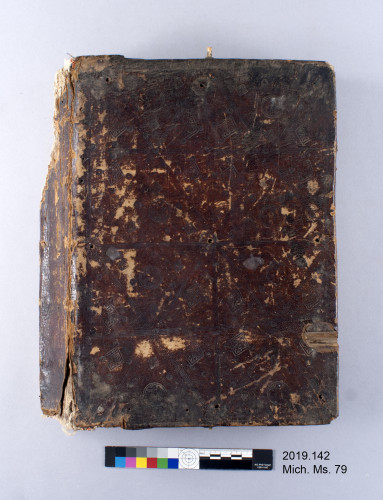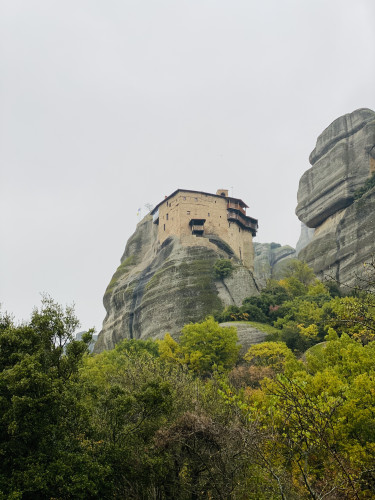Guest post by Kyle Clark, Conservation Technician, Preservation and Conservation, University of Michigan Library
The University of Michigan Library and the Detroit Institute of Arts (DIA) have recently collaborated in a project to produce x-ray images of the hidden structure inside a fourteenth-century Greek manuscript binding.

Lower board of Mich. Ms. 79

Top of the lower board of Mich. Ms. 79
This manuscript is part of an extraordinary collection of Greek manuscripts consisting of 110 codices (bound books) and fragments ranging from the fourth to the nineteenth century. In brief, these holdings include manuscripts written on parchment or paper, many of which display bindings made shortly after the text was copied. Some of these bindings show iconic elements such as elaborate multi-core endbands and plaited leather closure mechanisms, and some are bound with blind-tooled leather coverings. A full description of the first half of the Greek manuscript holdings will be published as the first volume of a much anticipated two-volume fully illustrated catalog: Nadezhda Kavrus-Hoffmann. Catalogue of Greek Manuscripts at the University of Michigan in Ann Arbor (with the collaboration of Pablo Alvarez). Vol. 1. Ann Arbor, MI: University of Michigan Press (forthcoming: March 2021). Moreover, a full description of the bindings of these manuscripts, including findings derived from the production of the facsimile of one of the bindings, will be published as a richly illustrated catalog: Julia Miller. Tradition and Individuality: Bindings from the University of Michigan Greek Manuscript Collection. Introduction by Pablo Alvarez. With contributions by Kyle Clark. Ann Arbor, MI: The Legacy Press (forthcoming: March 2021).

Monastery of St Nicholas Anapausas in the Meteora. Photo by Kyle Clark
As a conservation professional, my contribution to the project consists of the fully documented production of a facsimile binding of Mich. Ms. 79, a fourteenth-century Greek manuscript containing St John Chrysostom’s Eclogae which originated at the monastery of St Nicholas Anapausas in the Meteora (a group of monasteries built on high pinnacles of rocks in an area in Thessaly, the center of Greece). In order to fully understand the structural components and mysteries of the mechanical elements hidden within the binding, arrangements were made with Aaron Steele of the conservation department at the Detroit Institute of Arts (DIA) to produce an x-ray of the manuscript’s surviving lower board. At the DIA, Steele and I worked together to capture a glimpse of the interior of the board. This type of imaging has allowed me to see the work of the binder lying beneath the fourteenth-century leather covering, revealing evidence that has not been visible in over six hundred years. With the help of Aaron Steele and the x-radiographic images, I will be able to reproduce in facsimile form a more accurate interpretation of Mich. Ms. 79 in addition to documenting this particular method of board attachment. These structural discoveries and the resulting facsimile binding will be useful to conservation professionals, curators, rare book librarians, and cataloguers who work with medieval manuscript collections and, more broadly, they will be of interest to book historians.
Kyle Clark